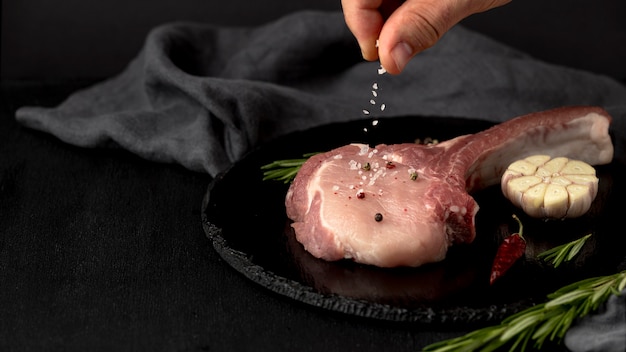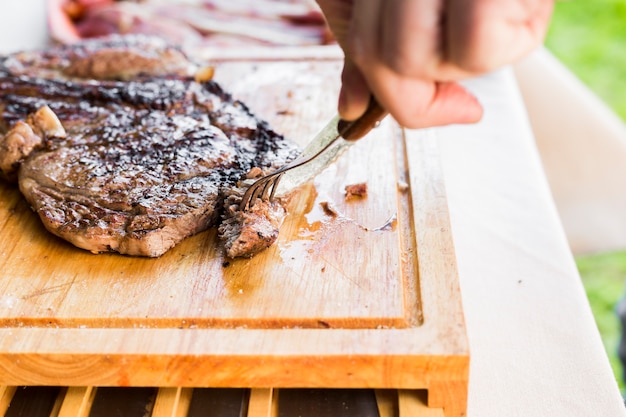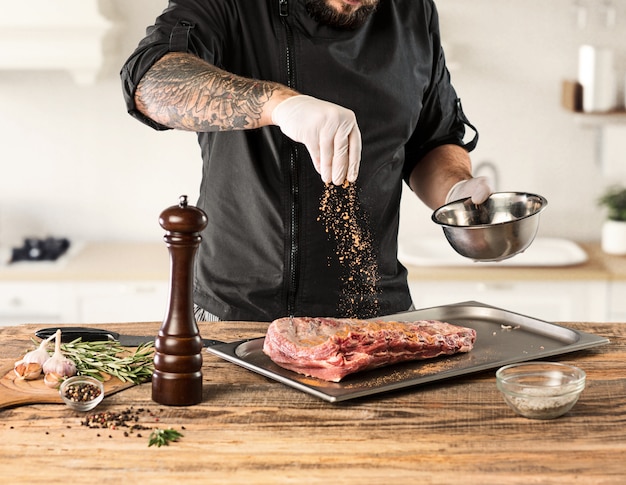(Part 1) Choosing the Perfect Cut: It All Starts With the Right Piece of Meat

What to look for in a beef loin steak:
Forget the flimsy supermarket options. Head to a reputable butcher or a good quality meat counter. Here's what you need to look for in a champion beef loin steak:- Marbling: Think of it like the frosting on a cake. It’s the fat that runs through the meat, giving it a richness and juiciness that'll make your taste buds sing. Look for a good amount of marbling throughout, it’s the key to a tender and flavorful steak. You want it to be evenly distributed, not just a few thick lines.
- Color: A dark red color is what you want. This usually means the meat is fresher and hasn’t been sitting around for ages. Avoid any cuts that look grey or have a brownish tinge, they've probably seen better days.
- Texture: Feel the meat. It should be firm and springy to the touch. A bouncy texture means it’s well-aged, and that's important for even cooking and a tender bite. If it feels mushy or limp, it’s probably not the best choice.
Don't be afraid to ask for help:
You wouldn't walk into a museum and expect to understand every artwork, would you? So, don't be shy when it comes to the meat counter. Ask the butcher for advice. They’re experts, and they want you to be happy with your purchase. Tell them what you’re planning to cook and what you like in a steak, and they'll guide you to the perfect cut. You'll learn a thing or two, and you'll end up with a steak that’s worth bragging about!Different cuts, different flavours:
Beef loin isn't a one-size-fits-all cut. There's a whole world of delicious options to choose from, each with its own unique personality and best uses.- Tenderloin: This is the most tender cut of the loin, and it's perfect for grilling because it cooks quickly and evenly. But be warned: it's also the most expensive. It's like the Rolls-Royce of steak cuts.
- strip steak: A bit more affordable than the tenderloin, the strip steak is a good all-rounder. It's a versatile cut that works well for grilling, pan-frying, or even broiling. It offers a good balance of flavour and tenderness.
- new york strip: Very similar to the strip steak but with a little more fat. That extra fat means it's even more flavorful and juicy. It's fantastic for searing, creating that beautiful, crispy crust that makes your mouth water.
Let's talk thickness:
Now, thickness is a big deal when it comes to steak. Personally, I'm a fan of a thick cut, around 1.5 to 2 inches. It cooks a bit more evenly and allows for that glorious, thick crust on the outside. But if you're looking for something quick and easy, a thinner cut, around 0.75 to 1 inch, is perfectly acceptable.(Part 2) Prepping Your Steak: Preparing for a Culinary Triumph

Let it come to room temperature:
This is a crucial step that many people overlook. Taking your steak out of the fridge about 30 minutes before cooking allows it to come to room temperature. This means it cooks more evenly and will be more tender. You don't want to cook a cold steak, it’ll be tough and chewy. Trust me, I've learned this the hard way.Dry it well:
Pat your steak dry with paper towels. This is important because it prevents steam from building up during cooking. Steam gets in the way of that beautiful sear you're after. Remember, the drier the surface, the better the crust.Seasoning: Less is more
Now, don't go crazy with fancy spices. Keep it simple. Salt and pepper are your best friends. Just a generous pinch of salt and a good grind of black pepper is all you need. If you want to go a little wild, a little bit of garlic powder can add a nice depth of flavor. But remember, the meat should be the star of the show!Don't forget the fat!
It's tempting to trim off all the fat, but resist the urge! That fat adds flavor and moisture to your steak. It’s the secret weapon that keeps your steak juicy and tender. Just trim off any excess that's really thick or looks like it might burn too quickly.(Part 3) The Art of Grilling: A Classic Method for a Reason

Get your grill hot:
You want your grill screaming hot, around 450-500°F. This is essential for that beautiful sear that gives your steak its incredible flavor. It's the same principle as searing a steak in a hot pan, but with the added bonus of smoky goodness.Oil it up:
Brush the grill grates with a little oil. This prevents the steak from sticking and helps you achieve those beautiful grill marks that show off your culinary prowess. It also gives the steak a lovely smoky flavor.Lay it down:
Place your steak on the hot grill, and resist the urge to move it around. Let it sit for about 2-3 minutes per side. This gives you that beautiful, caramelized crust that everyone loves.Flip it over and repeat:
Once the first side is nicely seared, flip the steak over and repeat the process. You'll get those lovely grill marks and a perfectly cooked exterior.Resting is key:
Now comes the crucial part. Once your steak is cooked to your liking, remove it from the grill and let it rest for 5-10 minutes before slicing. This allows the juices to redistribute, making your steak extra juicy and tender. The resting time is like the finishing touches on a painting; it's what brings everything together.(Part 4) Mastering the Pan-Frying Method: A Kitchen Classic
Grilling not your thing? No problem. Pan-frying is another great way to cook a beef loin steak. It's a simple and straightforward method that's perfect for any night of the week. Here's my pan-frying strategy:Choose the right pan:
You want a heavy-bottomed skillet, preferably cast iron. This will distribute heat evenly, ensuring that your steak cooks evenly without burning. Cast iron is ideal because it holds heat incredibly well, creating that perfect sear.Heat it up:
Get your pan smoking hot. This is the key to creating that irresistible crust. A hot pan will sear the steak quickly, locking in the juices and creating a beautiful, caramelized surface.Oil it up:
Add a generous amount of oil to the pan, just enough to coat the bottom. You want it to be shimmering hot before you add the steak.Lay it down:
Carefully place your steak in the pan and let it sit! Don't move it around for at least 2-3 minutes per side. This will allow the steak to sear properly and develop that delicious crust.Flip and repeat:
After the first side is nicely seared, flip your steak over and repeat the process. Keep an eye on it; you want it to be browned and caramelized on both sides.Let it rest:
Once the steak is cooked to your liking, remove it from the pan and let it rest for 5-10 minutes before slicing. That resting time is crucial for letting the juices redistribute, making your steak even more tender and flavorful.(Part 5) Understanding Different Levels of Doneness: A Guide to steak perfection
You've got to know your steak doneness! Don't just wing it, because overcooked steak is a tragedy. Here's a breakdown of the common levels of doneness, so you can get it right every time:| Doneness | internal temperature (°F) | Description |
|---|---|---|
| Rare | 125-130 | Cool center, red throughout. For those who like a good bite of red meat. |
| Medium-Rare | 130-135 | Warm center, with red parts. A classic choice for many, with a hint of pink in the center. |
| Medium | 140-145 | Pink inside, warm throughout. A safe option for those who like a little more cooked steak, with a hint of pink left. |
| Medium-Well | 150-155 | Light brown inside, warm throughout. For those who prefer a little less pink, but still want a juicy steak. |
| Well Done | 160 | Brown throughout, cooked thoroughly. A well-done steak is fully cooked, but can be dry if you’re not careful. |
Use a meat thermometer:
To make sure you're cooking your steak to the right temperature, it's always a good idea to use a meat thermometer. You can find one at any kitchen store or supermarket. Just insert it into the thickest part of the steak, avoiding the bone.(Part 6) Finishing Touches: Elevate Your Steak to New Heights
Your steak is cooked to perfection. But there's still room for a little bit of magic. Here are a few finishing touches that'll take your steak from good to extraordinary.The magic of butter:
I love finishing my steak with a pat of butter. It adds flavor and moisture. While the steak is resting, melt a tablespoon of butter in the pan or on the grill and baste the steak with the hot butter. The steam from the melted butter will envelop the steak, creating a luscious, tender texture. It's truly an amazing trick!A sprinkle of herbs:
Don't be afraid to get creative here. A sprinkle of fresh herbs, like parsley, rosemary, or even a touch of thyme, adds a vibrant touch of flavor. It's the perfect way to complement the richness of the steak.Garlic butter is a winner:
For a more intense flavor, try a garlic butter mixture. Simply add some minced garlic to your melted butter. The garlic will add a delicious pungent flavor, cutting through the richness of the steak.(Part 7) Serving Your Steak: A Feast for the Senses
Your steak is cooked, rested, and seasoned. Now it's time to serve it up, and create a meal that's as visually appealing as it is delicious.The perfect side dish:
Choose a side dish that complements your steak. Avoid overwhelming the flavour of your steak. Here are some of my favourites:- mashed potatoes: A classic for a reason. They're creamy, comforting, and go perfectly with the rich flavour of a steak.
- Roasted vegetables: A healthy and flavourful option. Try asparagus, broccoli, or Brussels sprouts. The slightly sweet, earthy tones of roasted vegetables complement the richness of steak beautifully.
- grilled corn on the cob: A summertime favourite. The sweetness of the corn goes perfectly with the savory steak. The charred flavor from grilling adds another layer of deliciousness.
- Salad: A refreshing and light option. A simple green salad with a vinaigrette dressing is always a good choice. It provides a welcome contrast to the richness of the steak.
Don't forget the sauce:
A good sauce can really elevate your steak. There are countless sauce options out there, but here are some that are perfect for beef loin steak:- Béarnaise sauce: A classic French sauce that's perfect for steak. It's rich, creamy, and slightly tangy, creating a luxurious experience.
- Red wine sauce: A rich and flavorful sauce that's perfect for steak. The fruity notes of red wine complement the meat beautifully.
- Mushroom sauce: A savory and earthy sauce that's perfect for steak. The umami flavour of mushrooms adds a depth of flavor that pairs perfectly with the steak.
- Peppercorn sauce: A spicy and flavorful sauce that's perfect for steak. The peppery kick adds a delightful contrast to the richness of the meat.
Serve it up:
When serving your steak, place it on a plate with your chosen side dishes and sauce. Don't be afraid to let your steak shine! Present it with care and attention, and your guests will be impressed by your culinary skills.(Part 8) FAQs
I’m always asked the same questions about cooking a steak to perfection, so let's get to it:Q: What is the best way to store a beef loin steak?
A: It's best to store it in the refrigerator, wrapped in plastic wrap or in an airtight container. It will stay fresh for 3-5 days. If you’re going to freeze it, make sure to use freezer-safe bags and remove as much air as possible. It's not ideal to freeze steaks for long periods as it can affect the quality of the meat. You can keep it in the freezer for up to 3 months, but it will be best if you use it within a month or two. Once it's thawed, don't refreeze it.
Q: How long should I cook a beef loin steak?
A: The cooking time will depend on the thickness of the steak and your desired level of doneness. A rule of thumb is about 2-3 minutes per side for rare to medium-rare. But you should always check the internal temperature with a meat thermometer to make sure it's cooked to your liking. For a 1-inch thick steak, it might take 4-6 minutes per side for medium-rare, while a 2-inch thick steak might need 6-8 minutes per side.
Q: What if my steak is overcooked?
A: Sadly, there's no magic fix for an overcooked steak. But you can make the best of it by adding a sauce that adds moisture and flavor. Also, make sure to slice the steak thinly to make it more tender. And try to learn from the experience!
Q: Can I use a marinade for my steak?
A: You can use a marinade if you like, but it's not necessary. If you do, make sure to marinate the steak for at least 30 minutes. This will allow the flavors to penetrate the meat. But don’t forget, less is more! A simple marinade with a little oil, lemon juice, and herbs can make a big difference. And remember, marinade doesn’t equal a good steak! Focus on getting the basics right.
Q: How do I know when my steak is cooked?
A: The best way to tell is by using a meat thermometer. But if you don't have one, you can use the touch test. If the steak is firm but springs back when you poke it, it's medium-rare. If it's firm and doesn't spring back, it's medium.
I hope this guide has helped you understand how to cook the perfect beef loin steak. It's a simple dish to prepare, but it requires some care and attention. Remember to choose a good cut of meat, prep it properly, and cook it to your liking. And don't forget to let it rest! With a little practice, you'll be grilling, pan-frying, and perfecting beef loin steak in no time.Everyone is watching

Corn on the Cob: The Ultimate Guide to Perfectly Cooked Ears
Healthy MealsAh, corn on the cob. Just the name evokes images of sunny days, barbecues, and that sweet, juicy flavour that ...

Perfect Pork Roast Oven Cooking Time: A Guide to Delicious Results
Healthy MealsThere's something truly satisfying about a perfectly roasted pork. The aroma alone is enough to make your mout...

Scallops: The Ultimate Guide to Perfect Cooking
Healthy MealsAh, scallops. Those delicate, sweet, and utterly delicious morsels of the sea. They hold a special place in my...

Ham Cooking Time: How Long to Bake, Smoke, or Boil a Delicious Ham
Healthy MealsAh, ham. It's a classic, isn't it? A real crowd-pleaser, especially around holidays. And when done right, it'...

Spaghetti Squash: The Ultimate Guide to Cooking and Serving
Healthy MealsRemember that time you saw spaghetti squash at the supermarket, looking all bumpy and strange, and thought, "W...
